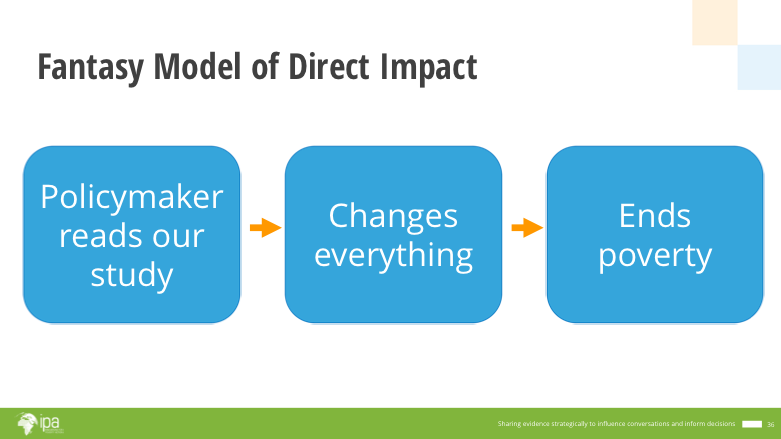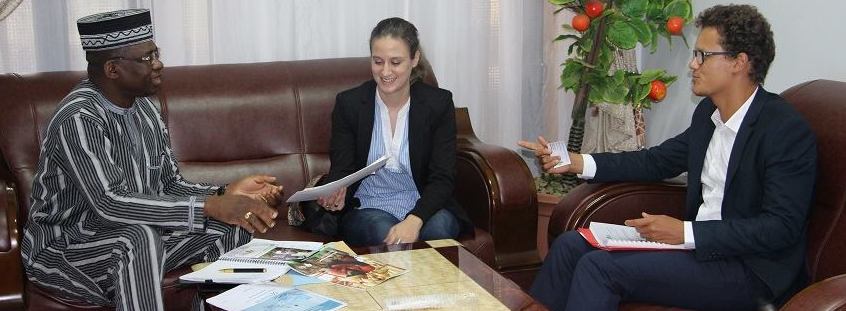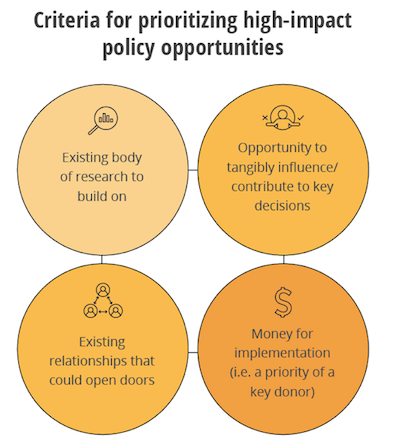How to Keep Good Research from Dying a Bad Death: Strategies for Co-Creating Research with Impact
Editor’s note: This is part three in a series on what IPA has learned about making sure evidence gets used, and what we hope to do more of in the future. See part one, laying out our new strategic ambition, here. Part two, on how to co-create evidence with partners to make sure your questions are relevant to them is here.
One of our favorite slides here at IPA, which we shamelessly plagiarized from David Evans, looks like this:

OK, so you might have thought that IPA thought the world worked this way. Like all good behavioral economists, however, we know the world doesn’t work that way… but how exactly are we supposed to get from research to policy impact?
IPA has a robust theory of action (the topic of this post), and many tools in our toolkit that help us get from point A to point B. But some of the most important tools come into play at one critical juncture: when the research funding runs out, the analysis is done, and the final grant report is complete. This is a crucial window of opportunity: either the team loses momentum and lets our partnerships and potential impact wither, or we continue to pursue next steps in policy and research.
But some of the most important tools come into play at one critical juncture: when the research funding runs out, the analysis is done, and the final grant report is complete.
Researchers are often invested in disseminating the results of their research to the practitioners and policymakers who helped enable it—but disseminating a paper, developing a brief, or even holding an event may not truly empower decision-makers to make changes based on the research. If you’re a researcher, funder, or practitioner who is interested in what can be done at this critical point to turn evidence into policy, read on!
Disseminate results in stages and determine next steps
Mapping evidence to real-world decisions and processes in order to determine the right course of action can be complex. Together with our partners, we gather the troops—researchers, implementers, and IPA’s research and policy team—and have a discussion around what the implications of the research are for policy and practice.

This staged dissemination is critically important: having private discussions first helps partners digest the results and think through their reactions in a lower-stakes setting. We help the partners think about not only the results, but how their stakeholders will respond to the results, and how we can support their ongoing learning, whether results are “good” or not as hoped. Later, we hold larger dissemination events to inform the public. But we try to work closely with researchers and implementers to think through next steps right after results are available—before the window of opportunity passes.
Identify & prioritize policy opportunities
Many of our partners have already written smart advice about how to identify policy opportunities (windows, openings… etc.), so there’s no need for us to restate all that great thinking (go read it!). However, we get asked frequently how we prioritize policy opportunities, and we do have a clear internal process for making that decision. Here are our criteria:

- A body of evidence to build on: One single study doesn’t often present the best policy opportunities. This is a generalization, of course, and there are exceptions, but typically our policy teams pay the most attention to bodies of evidence that are coming to a consensus. These are the opportunities for which we feel most able to recommend next steps related to policy and practice—there is a clearer message to communicate and research conclusions we can state with greater confidence.
- Relationships to open doors: Our long-term in-country presence and deep involvement with partners through research projects means that we have many relationships and doors open to us. Yet some of these relationships are stronger than others, and some partners are more influential in the processes we want to impact. We use stakeholder mapping tools to clarify who is invested and who has influence. We also track our stakeholder outreach to make sure our relationships stay strong and mutually beneficial.
- A concrete decision or process that we can influence: This is the typical understanding of a “policy opening,” and it’s an important one. What are the partner’s priorities, felt needs, and open questions? Where do those create opportunities for our influence? If the evidence would indicate one course of action, but that course isn’t even an option our partner would consider or be able to consider (for cost or other practical reasons), we have to give the opportunity a pass.
- Implementation funding: In the countries where we work, even when we have strong relationships, strong evidence, and the partner is open to influence, there is still one crucial ingredient missing: implementation funding. Addressing this constraint means getting evidence-based programming onto the agenda of major donors.
Get partners on board
Forming a coalition of partners and funders who will partner with us as we move forward is crucial. As a research and policy organization, we can’t scale effective solutions alone—nor is that the specialty that we want to develop, since there are others to fill that role. We need partners like Evidence Action Beta to help us pressure test solutions as they move towards scale, or partners like Living Goods who already have nationwide networks of community health workers who can reach communities efficiently and effectively. And we need governments who are willing to make public investments and decisions based on evidence.
Each policy opportunity can also be a learning opportunity
Finally: don’t forget the ongoing learning
Each policy opportunity can also be a learning opportunity—whether that is through rigorous evaluation at scale, high-quality process evaluations to ensure fidelity of implementation, and/or ongoing monitoring with tight feedback loops to improve program management. As we build stronger partnerships through careful results sharing, we also equip our partners to think more about what’s next – and what other things they want to learn along the way.
So after the data’s collected, and on its way to write up back in an office, someone has to consciously make a decision and face the now what? If you keep your head in the details it’s easy to look up and realize you’ve lost the momentum, the stakeholders have dispersed, and everybody has gone on to their next project. We hope these tools will help you figure out what to do to seize the moment and make sure your project makes a difference.












